



Domestic Abuse Prevention Inquiry Southampton 31 January 2019 Sara Kirkpatrick: Respect Research & Services Development Manager
The Role of Respect
A definition of domestic abuse Any incident or pattern of incidents of controlling, coercive or threatening behaviour, violence or abuse between those aged 16 or over who are or have been intimate partners or family members regardless of gender or sexuality. This can encompass, but is not limited to, the following types of abuse: psychological physical sexual financial emotional Controlling behaviour is: a range of acts designed to make a person subordinate and/or dependent by isolating them from sources of support, exploiting their resources and capacities for personal gain, depriving them of the means needed for independence, resistance and escape and regulating their everyday behaviour. Coercive behaviour is: an act or a pattern of acts of assault, threats, humiliation and intimidation or other abuse that is used to harm, punish, or frighten their victim.
Gendered nature of Intimate Partner Violence Intimate partner violence domestic abuse is a gendered issue. All analysis shows that IPV disproportionately affects women as victims. 1in 4 women 1 in 6 men often quoted from CSEW Over 83% of high frequency victims (more than 10 crimes) are women. (From a study of data from the Crime Survey for England and Wales, a nationally representative household survey.) (Walby & Towers, 2018) Men are more likely to be identified as repeat perpetrators from one study 82% males had more than one incident whereas female perpetrators in same study 62% had only a single incident. (Hester 2013) Homicide 2 women per week, 2 men per month Evan Stark when setting out his explanation of coercive control (2006) identifies women's inequality as a significant factor.
Gender matters Gender matters. Organisations work in a way that is gender informed, recognising the gender asymmetry that exists in the degree, frequency and impact of domestic violence and abuse. They understand that men’s violence against women and girls is an effect of the structural inequality between men and women and that its consequences are amplified by this. A gender analysis includes violence and abuse perpetrated by women against men and abuse in same-sex relationships, and these also require a gender informed response.
Levels of domestic abuse in the UK Police data indicates domestic abuse related offences make up 1 in 10 of all crimes The Office of National Statistics annual crime survey estimates that 1.9 million adults aged 16 to 59 years experienced domestic abuse in the year ending March 2017. Over 50% serious case reviews involve domestic abuse. Has higher levels of repeat victimisation than any other crime. Not always reported to the police Not always recognised as abusive by victim
Levels of domestic abuse in the UK What we do know about the underreported problem of domestic abuse is that initiatives such as routine enquiry continue to result in earlier or ‘better’ survivor support. This tells us we have not yet reached the tipping point where we can move from innovation to maintenance of availability of support. While targeted interventions, particularly those based on hotspot mapping can give positive indications of improvement in a specific area due caution should be given to overcommitment to this as a single or most productive approach.
Risk factors for domestic abuse Risk factors for victimisation: Personal vulnerability MH, physical disability, past abuse…
Risk Factors for Perpetratation Any factors that increase propensity to become a perpetrator? Higher recorded prevalence in SU populations (no causal link) Higher recorded prevalence in MH populations (no causal link) Repeat offenders of DVA present the highest likelihood of reoffending Weak or inconsistent justice response. Victim blaming narratives in media, society, and organisational responses. Young people exposed to domestic abuse have higher prevalence of both perpetration and victimisation as well as substance use and mental health problems, therefore providing robust children's supports and support for non abusive parent is important. Domestic abuse is both cause and consequence of gender inequality therefore the biggest factor which increases propensity to use abusive behaviour or continue to use abusive behaviour is social acceptance of ‘low level’ abusive or oppressive behaviour.
The importance of prevention - Initiatives that can help to decrease incidents of intimate partner abuse • Culture / system challenging the conducive context • Talk about equality- ie it’s a long standing problem because DVA is a symptom of VAWG • Swift consistent justice response • Reliable supportive victim survivor response for all responding agencies • Whole community response • Routine enquiry • Awareness raising campaigns • Leadership .
Work directly with perpetrators Without direct work with perpetrators of domestic abuse alongside support services and prevention work then domestic abuse will continue. This work must be undertaken safely and must be conducted as part of a systematic approach to tackling Violence against women and Girls. There is now good evidence of positive impact: community behavioural change programmes from Mirabal Emerging work with promising results: early interventions such as CARA (piloted here in Southampton), Intensive case management models such as DRIVE. As the appetite for innovation and a broader range of solutions to challenge or disrupt abusive behaviour increases these innovations should be developed in consultation and cooperation with survivor services.
Recommend
More recommend